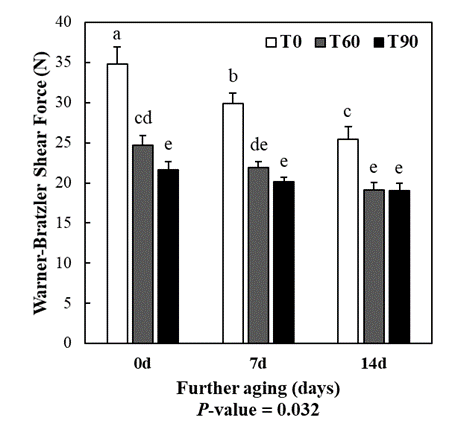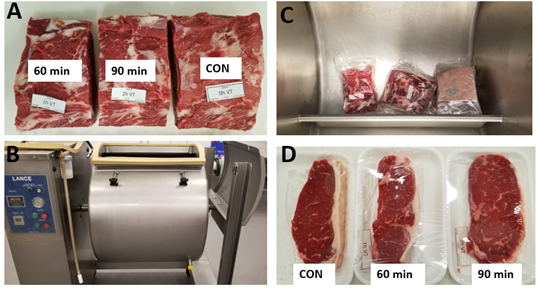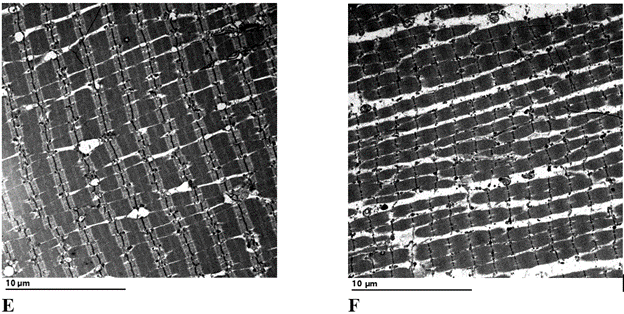Project Summary
Improved Beef Quality and Palatability through Novel Fresh Beef Tumbling and Aging
- Principle Investigator(s):
- Yuan H. Brad Kim and Jacob R. Tuell
- Institution(s):
- Purdue Meat Science and Muscle Biology Laboratory
- Completion Date:
- December 2020
Background
Failure to meet consumer expectations for tenderness of fresh beef products remains a primary concern of the meat industry, especially for inherently tough cuts originating from the fore- and hindquarters of the carcass. Numerous strategies have been employed to accelerate the tenderization process through physical disruptions to muscle structure and/or endogenous proteolytic enzymes. However, there exists a pressing need for developing natural post-harvest processing systems that produce beef products with improved eating quality attributes, given the growing consumer demand for natural/minimally processed fresh meat products. Simple tumbling of vacuum packaged fresh meat sections may represent a feasible means of improving fresh beef quality and palatability.
The objectives of this study were to (1) demonstrate feasibility of the tumbling of vacuum packaged fresh beef on improving quality attributes and proteolysis of beef M. Longissimus lumborum muscles, (2) evaluate the combined tumbling and aging process of varying durations on quality and consumer palatability of beef M. Longissimus lumborum and M. Semitendinosus, and (3) utilize the optimal tumbling duration to improve quality attributes across three beef sirloin muscles (M. Gluteus medius, M. Biceps femoris, and M. Tensor fasciae latae).
Methodology
A total of three experiments was conducted, where carcasses [n=9 (USDA Select) for Objective 1; n=16 (USDA Choice-) for Objectives 2 and 3] were obtained from a commercial processor, and paired muscles were obtained at 7d (1) and 5d (2, 3) postmortem. Sections were tight vacuum-packaged twice and allocated among tumbling treatments which were (in minutes) T0 control, T60, T90 (1); T0 control, T40, T80, T120 (2); and T0 control and T120 (3). Tumbled sections were further divided, and sub-sections were allocated to additional aging durations of 0d, 7d, 14d (1) or 0d and 10d (2, 3), after which steaks made. Meat quality attributes included pH, Warner-Bratzler shear force (WBSF), instrumental color, water-holding ability, among others. Extent of proteolysis was determined through myofibril fragmentation index (MFI), western blot of myofibrillar proteins, transmission electron microscopy (TEM), among others. For Objective 2, a separate 120 person consumer panel was conducted per each muscle to assess liking of various sensory attributes for both aging durations. For Objective 3, 10d further aged sirloin samples were evaluated for sensory descriptive scores by trained panel.
Findings
Overall, the results suggest the fresh beef tumbling without brine addition has a considerable improvement in tenderness of M. Longissimus lumborum muscles, while the improvement is less substantial for muscles originating from the sirloin and M. Semitendinosus. This translated to consumers finding tumbled beef M. Longissimus lumborum muscles to be more tender than T0 controls regardless of aging duration with no detriment to juiciness or flavor. Simple tumbling at lower speed resulted in immediate about 38% decreases in WBSF without further aging. While WBSF values were equivalent, there was a strong trend of improved liking of tenderness of tumbled and aged M. Semitendinosus muscles. Proteolysis results supported that tumbling disrupted muscle structure and degraded myofibrillar protein, although the impact of further aging was more substantial for degradation of myofibrillar proteins in most muscle types. Trained panel evaluators found no improvement in tenderness in M. Biceps femoris and M. Tensor fasciae latae muscles, finding them poorer for juiciness. However, the M. Gluteus medius was found to have superior myofibrillar tenderness with tumbling, in agreement with WBSF data, with no detriment to overall juiciness.
implications
Overall, the results suggest the fresh beef tumbling without brine addition has a considerable improvement in tenderness of M. Longissimus lumborum muscles, while the improvement is less substantial for muscles originating from the sirloin and M. Semitendinosus. This translated to consumers finding tumbled beef M. Longissimus lumborum muscles to be more tender than T0 controls regardless of aging duration with no detriment to juiciness or flavor. Simple tumbling at lower speed resulted in immediate about 38% decreases in WBSF without further aging. While WBSF values were equivalent, there was a strong trend of improved liking of tenderness of tumbled and aged M. Semitendinosus muscles. Proteolysis results supported that tumbling disrupted muscle structure and degraded myofibrillar protein, although the impact of further aging was more substantial for degradation of myofibrillar proteins in most muscle types. Trained panel evaluators found no improvement in tenderness in M. Biceps femoris and M. Tensor fasciae latae muscles, finding them poorer for juiciness. However, the M. Gluteus medius was found to have superior myofibrillar tenderness with tumbling, in agreement with WBSF data, with no detriment to overall juiciness.

Figure 1 from Objective 1. Effect of fresh beef tumbling and further aging on Warner-Bratzler shear force (WBSF) values (N) of beef loins. Means lacking a common superscript (a-e) differ at (P<0.05). Error bars indicate standard error of the mean.
Table 1 from Objective 2. Main effect of fresh beef tumbling on consumer (n=120) sensory scores for palatability traits of M. Longissimus lumborum muscles.
|
Treatment |
Tenderness |
Juiciness |
Flavor |
Overall liking |
|
T1 |
|
|
|
|
|
T0 |
66.6b |
69.2 |
66.5 |
66.4 |
|
T40 |
72.1a |
70.5 |
66.9 |
69.2 |
|
T80 |
73.8a |
70.6 |
68.3 |
69.7 |
|
T120 |
73.3a |
68.1 |
68.6 |
69.5 |
|
SEM |
2.2 |
2.0 |
1.7 |
1.9 |
|
Significance of P-value |
0.003 |
0.711 |
0.656 |
0.382 |
-
1Tumbling duration (min)
a,bMeans lacking a common superscript within a column differ at (P < 0.05) due to tumbling main effect.
photos

Representative photos demonstrating Simple tumbling of vacuum packaged fresh beef sections. (A) Treatment allocation to beef sections within each strip lon; (B) Lance LT-30 Meat Tumbler; (C) Each beef section was individually vacuum-packaged prior to tumbling; (D) Sliced beef steaks from each beef section after Smart Tumbling – no adverse impacts of Smart Tumbling on surface color, appearance/shape, and purge loss were found.

Representative transmission electron microscopy images at 2,550× magnification of M. Longissimus lumborum muscles before (E) and after (F) T120 treatment.